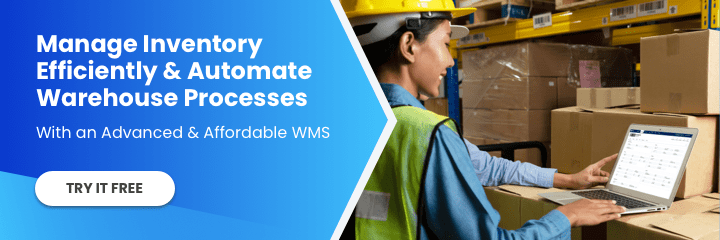For more information about warehouse management systems or technology trends, follow us on LinkedIn, YouTube, X, or Facebook. If you have other inquiries or suggestions, please contact us here. We’ll be happy to hear from you.
Implementing a WMS can optimize your warehouse processes, improve inventory accuracy, and enhance overall operational efficiency. But where do you begin? This guide will walk you through the entire process of WMS implementation, from initial planning to final execution, covering key aspects such as system selection, data integration, and employee training.
Click Here: Boost Your Warehouse Efficiency With This Advanced and Affordable WMS
Follow our step-by-step instructions, leverage valuable insights, and avoid common pitfalls to ensure a successful WMS implementation that aligns with your unique business needs. Read the full article.
What is WMS Implementation and Its Benefits?
WMS, or Warehouse Management System, implementation refers to setting up and integrating a software system designed to manage and control the warehouse or distribution center operations efficiently. This implementation involves a series of steps and activities to ensure that the WMS functions effectively and meets the specific needs of the organization.

Implementing a warehouse management system (WMS) can bring numerous benefits to your business, such as:
1. Real-Time Visibility
Firstly, a WMS provides real-time visibility into your inventory, allowing you to track stock levels, locations, and movements accurately. This visibility enables better inventory management, reducing stockouts and overstock situations.
2. Automation
Secondly, a WMS automates manual warehouse processes, reducing human errors and increasing operational efficiency. Tasks such as receiving, picking, packing, and shipping can be streamlined using barcode scanning, automated workflows, and optimized picking routes. This automation not only saves time but also improves accuracy, leading to higher customer satisfaction and repeat business.
3. Data Insights
A WMS provides valuable data insights to help you make data-driven decisions. By analyzing key performance indicators (KPIs) such as order cycle time, order accuracy, and labor productivity, you can identify areas for improvement and implement strategies to optimize your warehouse operations further.
Implementing a WMS can improve inventory accuracy, increase operational efficiency, and provide valuable data insights, ultimately helping you streamline your warehouse operations and stay ahead of the competition. To learn more about the benefits of a WMS, read this article.
What is the Role of Supply Chain Orchestration?
Warehouse Management System (WMS) implementation typically involves several phases to ensure a successful deployment. These phases may vary depending on the specific needs of your organization, but the following are common phases in a WMS implementation project:
Phase 1: Preparation for WMS Implementation
The first step in the WMS implementation process is to lay a solid foundation for success. Here are some key steps to prepare for WMS implementation:
- Assess Your Current Warehouse Processes: Conduct a thorough evaluation of your existing warehouse processes to identify pain points, inefficiencies, and areas for improvement. Document your findings and use them to select the right WMS for your business.
- Set Clear Objectives: Clearly define your goals and objectives for implementing a WMS. Are you looking to improve inventory accuracy, reduce order cycle time, or increase labor productivity? Setting clear objectives will help you measure the success of your WMS implementation.
- Engage Key Stakeholders: Involve key stakeholders, such as warehouse managers, IT personnel, and employees, in the decision-making process. Their insights and feedback are crucial for selecting the right WMS and ensuring smooth implementation.
- Allocate Resources: Determine the resources required for successful WMS implementation, including budget, time, and personnel. Allocate these resources accordingly to avoid delays and setbacks.
- Create a Project Plan: Develop a comprehensive project plan that outlines the timeline, milestones, and responsibilities for each phase of WMS implementation. This plan will serve as a roadmap for the entire project and help keep everyone aligned.
By taking these preparatory steps, you’ll set yourself up for a successful WMS implementation that addresses your business needs and goals.
Phase 2: Choosing the Right WMS for Your Business
Once you have assessed your warehouse needs and goals, it’s time to evaluate different WMS options. Begin by researching and shortlisting potential vendors based on their reputation, customer reviews, and industry expertise. Contact these vendors to request demos and gather more information about their products and services.
During the evaluation process, consider factors such as the vendor’s experience in the industry, the stability and reliability of their software, and their track record of successful implementations. Ask for references from existing customers and inquire about their experiences with the system and the vendor’s support and training services.
It’s also crucial to consider scalability and future growth. Your business may expand, and your warehouse operations may become more complex. Therefore, choosing a WMS that can scale with your business and accommodate your future needs is essential.
Consider factors such as the number of users the system can support, the maximum volume of inventory it can handle, and whether it can integrate with other systems and software that you may adopt in the future. Look for a vendor that has a proven track record of supporting businesses through growth and can provide scalable solutions.
Phase 3: System Configuration, Data Migration, & Integrations
Customize the WMS to meet your specific business requirements. This may include setting up user roles, defining workflows, and configuring reports.
Additionally, transfer existing data from your legacy systems to the new WMS. Take this opportunity to clean and validate your data to ensure accuracy and integrity.
Integrating the WMS with your enterprise resource planning (ERP), logistics CRM, and transportation management systems can also streamline data flow and enhance visibility across the supply chain.
Phase 4: Testing and Validation
Conduct rigorous testing to ensure the WMS functions as expected. Test various scenarios, such as order processing, inventory management, and reporting, to identify and resolve any issues before going live.
Phase 5: Training and Onboarding
Effective training and onboarding are crucial for a successful WMS implementation. Your warehouse staff must understand how to navigate the new system and leverage its capabilities to streamline daily tasks. Here are some best practices for training and onboarding WMS users:
- Comprehensive Training: Develop a training program covering all WMS aspects, from basic navigation to advanced functionalities. Consider offering different training formats, such as classroom sessions, online modules, and hands-on exercises.
- Tailored Training: Customize the training program to suit different user roles and responsibilities. Warehouse managers may require more in-depth training on system administration and reporting, while pickers and packers may need focused training on order processing and inventory management.

Phase 6: Go Live and Continuous Improvements
Once the testing and training phase is successful, roll out the WMS to the entire warehouse or distribution center. Monitor the system’s performance closely and address any issues that may arise during the initial stages of full-scale operation.
Additionally, offer ongoing technical support to address user issues and perform routine maintenance. If it is an on-premise WMS, always keep it up-to-date with software updates, patches, and upgrades. If it is a WMS SaaS, updates are automatically rolled out by the software company. Conduct regular reviews and assessments to ensure that the WMS continues to meet your evolving business needs. Here are some best practices to facilitate continuous improvement:
- Ongoing Support: Offer post-training support to address user questions and concerns. Assign dedicated resources, such as a helpdesk or an internal WMS expert, to provide timely assistance and ensure users feel confident using the new system. Your WMS vendor must also provide ongoing support.
- User Feedback: Encourage users to provide feedback on the WMS. Regularly evaluate their effectiveness in using the software.
Frequently Asked Questions:
1. What is the purpose of WMS?
WMS, or Warehouse Management System, is a software application or system designed to streamline and optimize the operations within a warehouse or distribution center. The primary purpose of a WMS is to efficiently manage and control various warehouse activities to improve overall productivity, accuracy, and customer service.
To learn all about WMS, click here.
2. Why should WMS be implemented in a warehouse?
Implementing a Warehouse Management System (WMS) offers several compelling benefits for warehouses and distribution centers, such as improved efficiency, accuracy, better inventory management, space optimization, and more.
To learn about the importance of a WMS, click here.
3. How long does a WMS implementation take?
The duration of a Warehouse Management System (WMS) implementation can vary significantly based on several factors, including the complexity of the warehouse, the chosen WMS solution, the operation’s size, and the organization’s readiness to adopt the new system. However, a typical WMS implementation can take several months to over a year.
Conclusion
This guide provides a comprehensive overview of the essential steps involved in the WMS implementation process, right from the initial planning phase to successful execution. By following these steps, warehouse operators can select the appropriate WMS for their business and benefit from real-time visibility, automation, data insights, and improved customer service.
WMS implementation is a journey that starts with understanding your warehouse’s unique needs and objectives, choosing the right system, customizing it to fit your requirements, and thoroughly testing and training your workforce. It’s not just a one-time project but a continuous commitment to improvement.
If you are considering a WMS implementation for the first time or upgrading your existing system, this guide is an invaluable resource to help you navigate the journey toward optimized warehouse operations.












